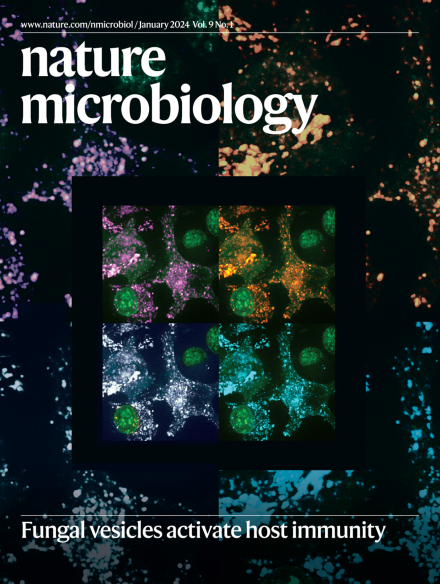宿主范围广泛的噬菌体在生态系统中很常见。
IF 19.4
1区 生物学
Q1 MICROBIOLOGY
引用次数: 0
摘要
噬菌体在微生物群落中丰富多样,在其进化和适应中发挥着重要作用。噬菌体的复制和增殖通常被认为局限于单一或狭窄的宿主范围内。在这里,我们使用来自不同环境的已发表的和新生成的基于邻近连接的宏基因组Hi-C (metaic)数据来探索病毒与宿主的相互作用。我们重建了4975个微生物基因组和6572个中等或更高质量的噬菌体基因组。metaic产生了基因组之间的接触网络,并使大约一半的噬菌体基因组能够分配给它们的宿主,揭示了这些噬菌体的很大一部分与多种环境中的多种物种相互作用,如海洋水柱或人类肠道。这一观察结果挑战了噬菌体宿主谱狭窄的传统观点,揭示了多宿主关联在生态系统中是常见的,这对它们如何影响生态和进化以及噬菌体治疗方法具有重要意义。本文章由计算机程序翻译,如有差异,请以英文原文为准。

Phages with a broad host range are common across ecosystems
Phages are diverse and abundant within microbial communities, where they play major roles in their evolution and adaptation. Phage replication, and multiplication, is generally thought to be restricted within a single or narrow host range. Here we use published and newly generated proximity-ligation-based metagenomic Hi-C (metaHiC) data from various environments to explore virus–host interactions. We reconstructed 4,975 microbial and 6,572 phage genomes of medium quality or higher. MetaHiC yielded a contact network between genomes and enabled assignment of approximately half of phage genomes to their hosts, revealing that a substantial proportion of these phages interact with multiple species in environments as diverse as the oceanic water column or the human gut. This observation challenges the traditional view of a narrow host spectrum of phages by unveiling that multihost associations are common across ecosystems, with implications for how they might impact ecology and evolution and phage therapy approaches. Proximity-ligation-based sequencing from 111 samples and 5 environments reveals that a substantial proportion of phages infect multiple species.
求助全文
通过发布文献求助,成功后即可免费获取论文全文。
去求助
来源期刊

Nature Microbiology
Immunology and Microbiology-Microbiology
CiteScore
44.40
自引率
1.10%
发文量
226
期刊介绍:
Nature Microbiology aims to cover a comprehensive range of topics related to microorganisms. This includes:
Evolution: The journal is interested in exploring the evolutionary aspects of microorganisms. This may include research on their genetic diversity, adaptation, and speciation over time.
Physiology and cell biology: Nature Microbiology seeks to understand the functions and characteristics of microorganisms at the cellular and physiological levels. This may involve studying their metabolism, growth patterns, and cellular processes.
Interactions: The journal focuses on the interactions microorganisms have with each other, as well as their interactions with hosts or the environment. This encompasses investigations into microbial communities, symbiotic relationships, and microbial responses to different environments.
Societal significance: Nature Microbiology recognizes the societal impact of microorganisms and welcomes studies that explore their practical applications. This may include research on microbial diseases, biotechnology, or environmental remediation.
In summary, Nature Microbiology is interested in research related to the evolution, physiology and cell biology of microorganisms, their interactions, and their societal relevance.
 求助内容:
求助内容: 应助结果提醒方式:
应助结果提醒方式:


